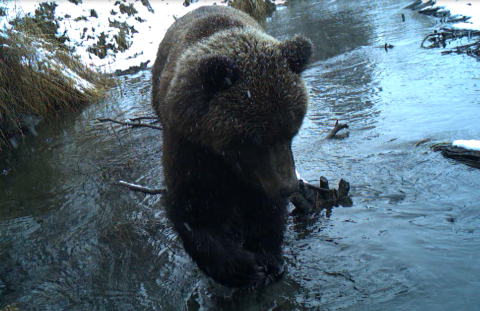In every winter, wildlife feels the impact of the challenge winter brings. You may have noticed moose more frequently as they take advantage of the snow free areas that plowed roads offer and browsing on the landscaping in your yard.
The long legs of moose make them built for navigating deep snow and can help them access new heights and food that they normally cannot reach. Still, deep snow can limit moose to smaller areas and resources, even limiting them to subpar food sources, and snow takes additional energy to travel through at time that is already energetically challenging.
As a result, each spring, it is normal to see winter-killed animals. The carcasses of winter-killed moose are a boon for bears and other scavengers as bears begin emerging from dens, witnessed by the return of their tracks in the snow.
So, what does this mean for you? It means being aware of carcasses as an attractant to bears. If you smell or see a carcass, or see concentrations of scavenger birds like ravens, don’t investigate it, as it is likely a carcass that has or will attract a bear. Once a bear finds a carcass, it will defend this valuable food source. For people, carcasses are an attractant that adds another element to be on the lookout for when out and enjoying outdoor activities.
The Kenai Peninsula, termed by many as "Alaska in miniature," holds over 2,000 species and every habitat present in Alaska, except the Arctic tundra. Located on one of the few road systems in the state and coupled with unparalleled recreational experiences we see more than 1 million visitors each summer. It is no wonder the human population has grown from 5,000 people to nearly 60,000 since the Refuge establishment 80 years ago.
In many ways, this is very familiar to me from my time living, working, and recreating in a place very similar, the lands around Yellowstone National Park. As we share a more crowded landscape, I prepare myself, there and here, to see bears anywhere, and at any time because den entrance and emergence dates are variable. However, especially now, as we move into spring and bears wake up.
Interactions take many forms and we have seen the most precarious interactions are surprise encounters. This can happen when fishing, hunting, hiking, and mountain biking and we suddenly find ourselves in the same space as a bear. These quiet pursuits make it easy to surprise a bear.
A few things we can all do to reduce the chance of surprising a bear is to make noise by talking or singing. Additionally, slowing down around curves in trails or in areas of dense vegetation can help. Recreate in groups of three or more and carry bear spray and know how to use it.
Being aware of our surroundings is important as well. Look for bear sign, including fresh scat and tracks in the snow. Again, if you smell a carcass, be mindful that it may be attracting bears. Never approach a bear or run away from a bear.
In addition to recreating in bear country, our homes are peppered throughout excellent bear habitat on the Peninsula, some places better than others, and the Refuge offers great camping opportunities. Unfortunately, both at home and while camping, we can unknowingly attract bears by having trash accessible.
Bears become “food-conditioned” when they obtain unsecured trash and acquaint our campsites and homes with food. As they continue to receive food rewards, they become bolder around people and can threaten human safety.
While camping, I like to keep food stored in my locked car and have a bear-resistant cooler. The Refuge offers bear-resistant trash cans at our campsites as well.
At home, I secure our trash in the garage. Don’t have one? There are several bear-resistant container available.
Living and recreating in bear country, we are asked to meet the unique challenge of staying safe in the outdoors while supporting wildlife diversity. These few simple actions will help us steward this magnificent place we all love and keep us and bears safer as we enjoy and share the same landscape.
Learn more about the actions you can take to reduce negative interactions with bears





